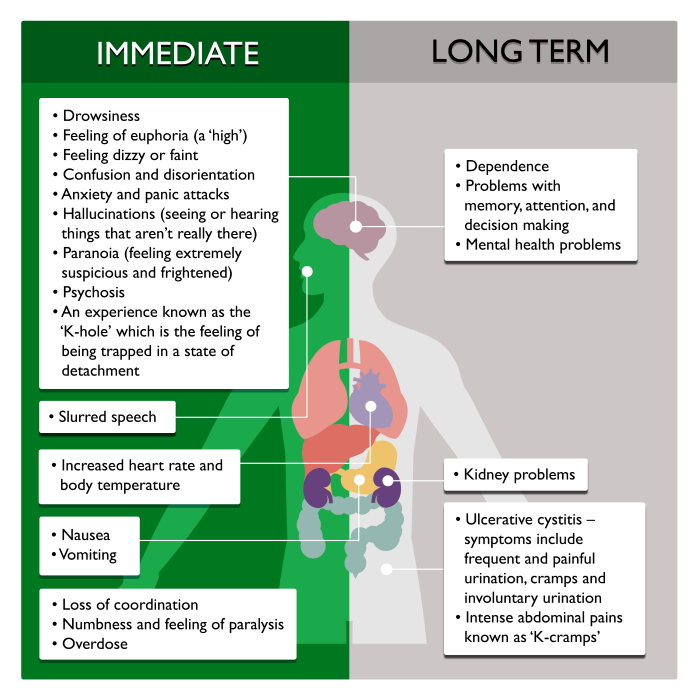What is Ketamine?
Ketamine is also known as K, Ket, special K, Vitamin K, or horse tranquiliser.
Ketamine (ketamine hydrochloride) is a white powder, usually sold in ‘bumps’ or grams. A ‘bump’ is a small amount of powder which is snorted through a small glass inhaler called a bumper. Ketamine can also be swallowed, smoked, or injected.
Ketamine is commonly used by veterinarians to sedate animals such as horses. As with all drugs sold in powder form, ketamine may also be sold ‘cut’ (mixed) with other white powder substances which may or may not be harmful- people using this drug can never be 100% sure of what they’re getting.
What are the effects of Ketamine?If snorted or ‘bumped’, ketamine takes effect within 5-10 minutes (longer if swallowed). Its effects can last for a couple of hours.
The effects of ketamine vary, but may include:
| Immediate |
Long-term |
| Increased heart rate and body temperature |
Dependence (see glossary) |
| Drowsiness |
Problems with memory, attention, and decision making |
| Feeling of euphoria (a ‘high’) |
Mental health problems |
| Loss of coordination |
Ulcerative cystitis – symptoms include frequent and painful urination, cramps and involuntary urination. |
| Slurred speech |
Intense abdominal pains known as ‘K-cramps’ |
| Feeling dizzy or faint |
Kidney problems |
| Confusion and disorientation |
|
| Numbness and a feeling of paralysis |
|
| Nausea and vomiting |
|
| Anxiety and panic attacks |
|
| Hallucinations (seeing or hearing things that aren’t really there) |
|
| Paranoia (feeling extremely suspicious and frightened) |
|
| Psychosis (see glossary) |
|
| An experience known as the ‘K-hole’ which is the feeling of being trapped in a state of detachment. This can be frightening |
|
| Overdose |
|

Evidence BaseThis factsheet was developed following expert review by researchers at the Matilda Centre for Research in Mental Health and Substance Use at the University of Sydney, the National Drug & Alcohol Research Centre at the University of New South Wales, and the National Drug Research Institute at Curtin University.
- Morgan, C.J. and Curran, H.V., 2012. Ketamine use: a review. Addiction. 107(1): p. 27-38.
- Jansen, K.L.R., 2000. Review of the nonmedical use of ketamine: use, users and consequences. Journal of Psychoactive Drugs.
32(4): p. 419-433.
- Sindicich, N. and Burns, L., 2012. Australian Trends in Ecstasy and related Drug Markets 2011. Findings from the Ecstasy and
Related Drugs Reporting System (EDRS). Australian Drug Trend Series No. 82. , National Drug and Alcohol Research Centre,
University of New South Wales: Sydney.
- MIMS online, 2012. MIMS online accessed 23 August 2012 via UNSW www.mimsonline.com.au.
- Garlepp, D., Johansen, M. and Gerstner- Stevens, J., 2012. Methorphan and piperazine derivatives in illicit drug seizures in
Victoria. Paper presented at 21st International ANZFSS Symposium. Hobart, 23-27 September.
- Rosenbaum, C.D., Carreiro, S.P. and Babu, K.M., 2012. Here today, gone tomorrow...and back again? A review of herbal marijuana
alternatives (K2, Spice), synthetic cathinones (bath salts), kratom, Salvia divinorum, methoxetamine, and piperazines. Journal
of Medical Toxicology. 8(1): p. 15-32.
- Wood, D.M. and Dargan, P.I., 2012. Novel Psychoactive Substances: How to Understand the Acute Toxicity Associated With the
Use of These Substances. Therapeutic Drug Monitoring. 34(4): p. 363-367.
- Hofer, K.E., Grager, B., Muller, D.M., Rauber-Luthy, C., Kupferschmidt, H., Rentsch, K.M. and Ceschi, A., 2012. Ketamine-like
effects after recreational use of methoxetamine. Annals of Emergency Medicine. 60(1): p. 97-9.
- Australian Institute of Health and Welfare, 2017. 2016 National Drug Strategy Household Survey report, AIHW: Canberra.
- Winstock, A.R. and Mitcheson, L., 2012. New recreational drugs and the primary care approach to patients who use them. BMJ.
344(Feb 15 1): p. e288-e288.
- Dillon, P., Copeland, J. and Jansen, K., 2003. Patterns of use and harms associated with non-medical ketamine use. Drug and
Alcohol Dependence. 69(1): p. 23-28.
- Stirling, J. and McCoy, L., 2010. Quantifying the psychological effects of ketamine: from euphoria to the K-hole. Substance Use
and Misuse. 45(14): p. 2428-2443.
- Reynaud-Maurupt, C., Bello, P.-Y., Akoka, S. and Toufik, A., 2003. Characteristics and behaviors of ketamine users in France in
2003. Journal of Psychoactive Drugs. 39(1): p. 1-11.
- Jansen, K.L.R. and Darracot-Cankovic, R., 2001. The nonmedical use of ketamine, part two: A review of problem use and
dependence. Journal of Psychoactive Drugs. 33(2): p. 151-158.
- van Amsterdam, J.G., Brunt, T.M., McMaster, M.T. and Niesink, R.J., 2012. Possible long-term effects of gamma-hydroxybutyric
acid (GHB) due to neurotoxicity and overdose. Neuroscience and Biobehavioral Reviews. 36(4): p. 1217-27